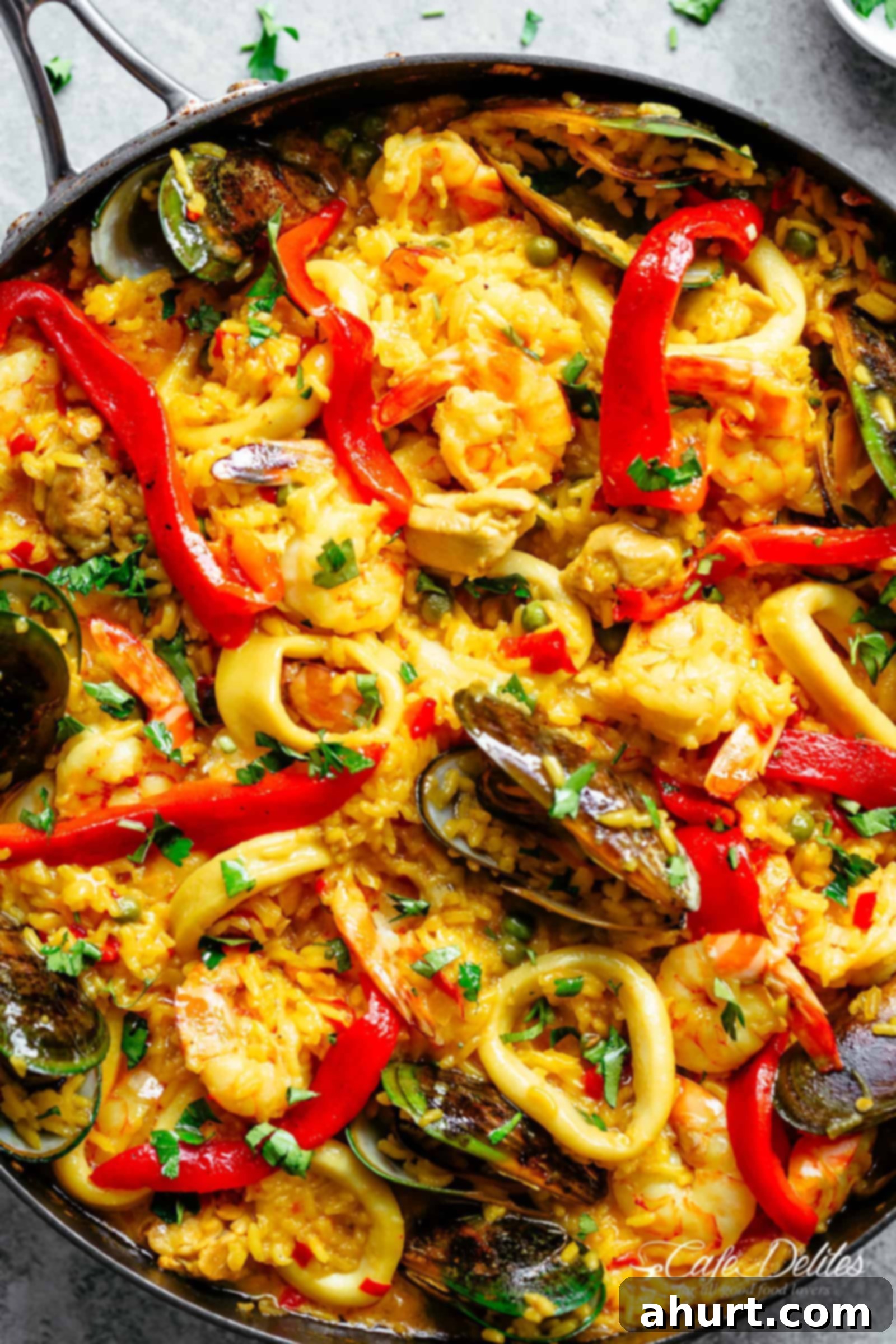Authentic Classic Spanish Paella Recipe: Master the Art of Saffron-Infused Seafood & Chicken Perfection
Embark on a culinary journey to the heart of Spain right from your kitchen with this remarkable Classic Spanish Paella. Far from just a meal, paella is an experience – a vibrant celebration of flavors and textures that rivals any restaurant creation. Imagine perfectly cooked, saffron-infused rice, studded with succulent seafood and tender chicken, all culminating in that highly coveted, irresistible golden crust known as socarrat. Every spoonful delivers a bold, traditional taste that transports you to the sun-drenched coasts of Valencia, the birthplace of this iconic dish.
What truly elevates this paella recipe beyond the ordinary is its incredible versatility. While our classic version features a delightful medley of seafood and chicken, the beauty of paella lies in its adaptability. Feel free to personalize it: add more of your favorite shellfish, incorporate spicy chorizo for a deeper flavor profile, or even make it a vegetarian delight. Paella is inherently a communal dish, designed for sharing and customizing, making it a favorite for gatherings and family meals. And let’s be honest, who can resist the allure of a truly authentic and delicious Spanish paella?
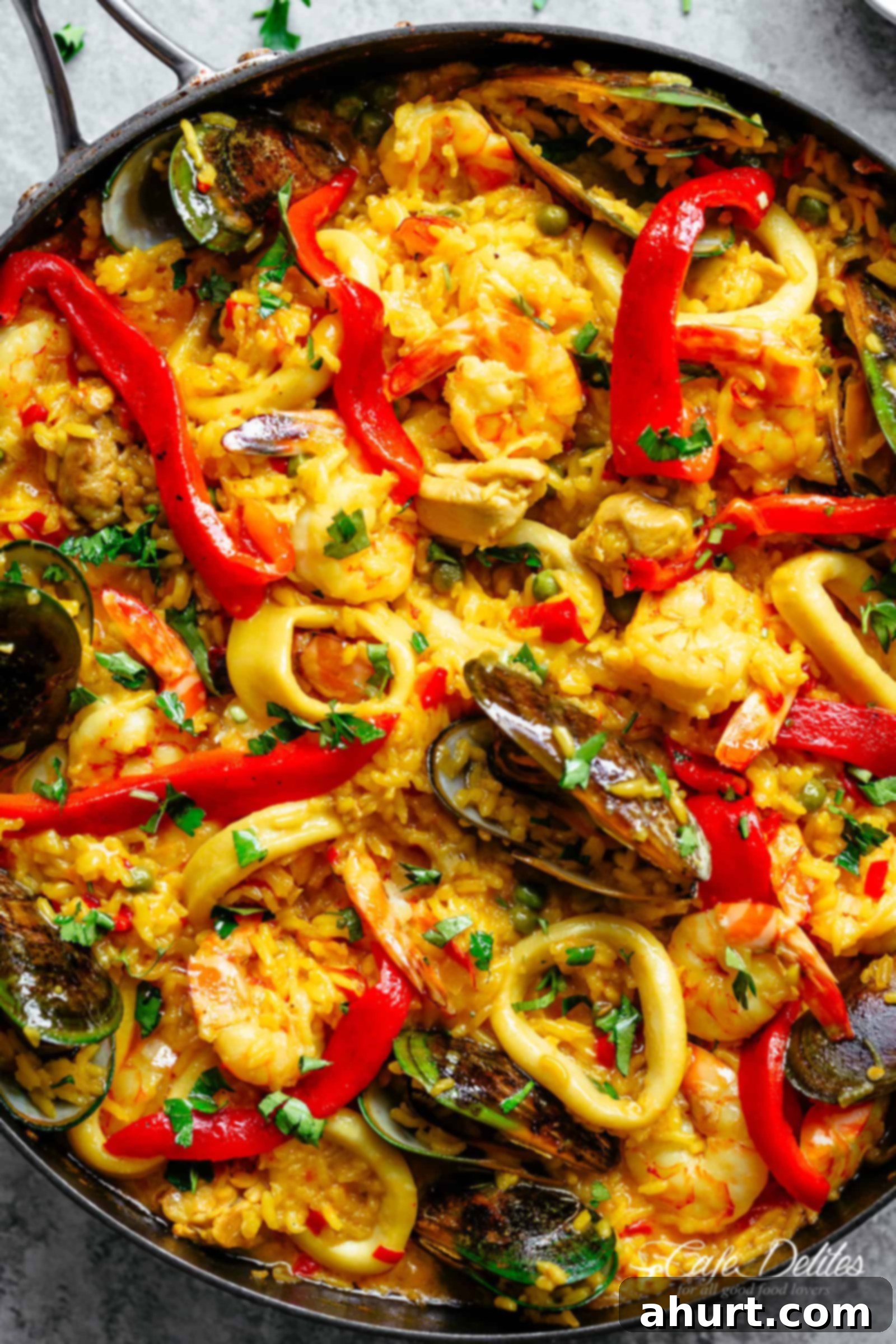
Unlock the Secrets: What Makes This Paella Truly Exceptional?
The magic behind this exquisite Spanish Paella lies in its harmonious balance of robust flavors and surprisingly straightforward technique. It’s more than just a dish; it’s a symphony of culinary elements working in perfect concert. The cornerstone is the rich, aromatic sofrito—a meticulously sautéed base of onions, garlic, and bell peppers that forms the foundational flavor. Layered upon this, the golden, saffron-infused rice absorbs every drop of savory broth, while tender, perfectly cooked seafood and juicy chicken contribute a delightful variety of textures and tastes. But the true hallmark, the signature touch that makes every bite truly unforgettable, is the elusive socarrat: that golden, slightly caramelized crust that forms at the bottom of the pan.
Despite its gourmet appearance and complex flavor profile, this paella recipe is remarkably approachable for home cooks. You don’t necessarily need specialized equipment or years of experience. While a traditional paella pan (paellera) is fantastic for its wide surface and shallow depth, a wide non-stick skillet or a well-seasoned cast iron pan with low sides will yield excellent results. The key ingredients are simple yet potent, and a little patience is all that’s required to coax out their full potential. Whether you’re a novice stepping into the world of Spanish cuisine or a seasoned chef preparing a festive meal, this recipe consistently delivers an authentic and deeply satisfying experience that will impress everyone at your table.
Essential Ingredients for Authentic Spanish Paella
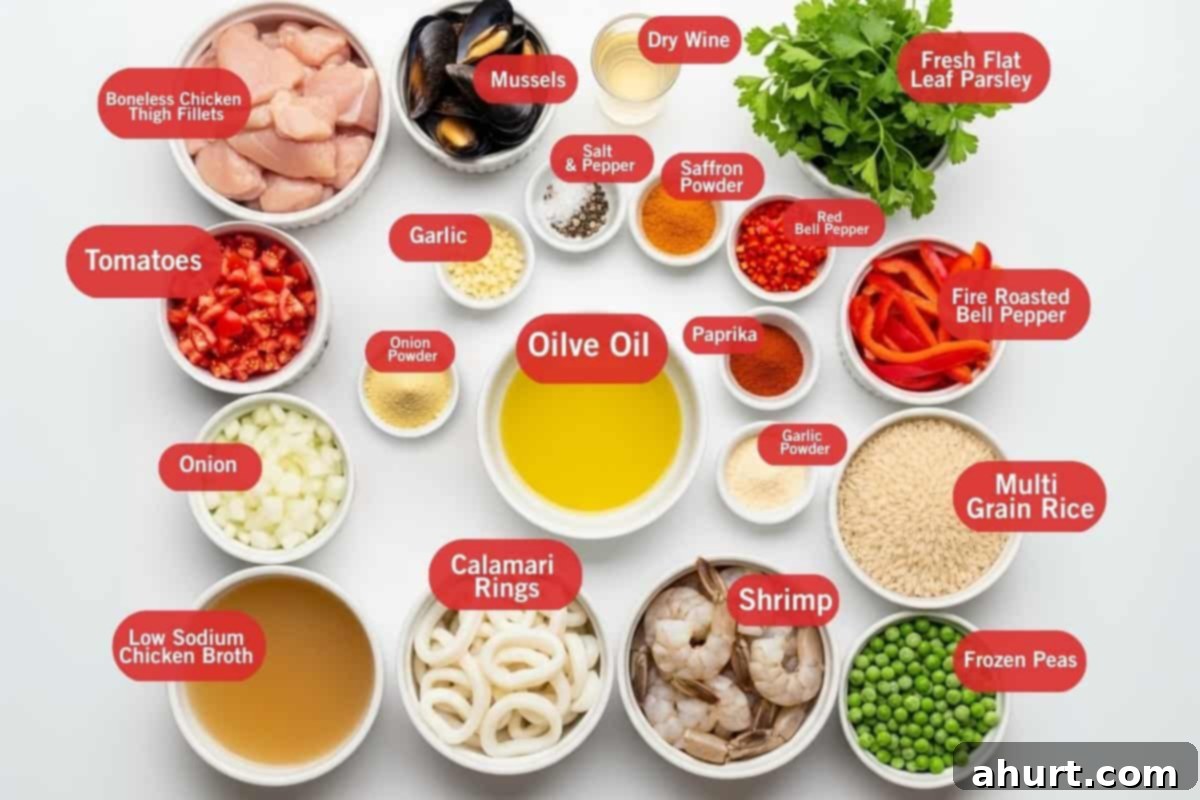
This classic Spanish Paella is a symphony of vibrant, fresh ingredients that meticulously layer together to create a deep, complex, and incredibly savory flavor profile with beautiful textures. Each element plays a crucial role in building the authentic soul of this celebrated dish, from the fragrant saffron to the perfectly cooked seafood.
- Saffron Powder (or Threads): This precious spice is non-negotiable for true paella. Just a small amount infuses the rice with its signature golden hue and distinct, subtle earthy-floral flavor, which is absolutely essential for an authentic experience. If using threads, steep them in a bit of warm broth before adding.
- Chicken Thigh Fillets: Opt for boneless, skinless chicken thighs. Their rich flavor and tender texture hold up exceptionally well during the cooking process, absorbing all the aromatic spices and savory broth without drying out. Cut into bite-sized pieces for even cooking and distribution.
- Mussels and Shrimp (Prawns): A delightful combination of fresh shellfish is key to a traditional seafood paella. Mussels add a briny, ocean-fresh taste and a beautiful presentation as they open, while plump shrimp (or prawns) cook quickly and offer a sweet, delicate flavor. Ensure they are fresh and properly cleaned.
- Medium Grain Rice: The choice of rice is paramount. Medium-grain varieties like Bomba or Calasparra are ideal because they possess a unique ability to absorb a large amount of liquid and flavor while still retaining their shape and developing that essential socarrat crust. Avoid long-grain or risotto rice as they won’t yield the correct texture.
- Sofrito Base (Onions, Garlic, Bell Peppers, Tomatoes): This aromatic foundation is the heart of paella’s flavor. Slowly sautéed onions, garlic, and diced red bell pepper create a sweet, savory base. Freshly chopped tomatoes then break down to form a rich, unctuous sauce that binds all the flavors together.
- Broth (Chicken or Fish Stock): Use a high-quality, low-sodium chicken or fish stock. This liquid is the lifeblood of the paella, as the rice absorbs its essence. For an even richer seafood flavor, homemade fish stock is highly recommended.
- Dry White Wine (Optional but Recommended): A splash of dry white wine (like Sauvignon Blanc or Pinot Grigio) deglazes the pan, adding a layer of acidity and complexity that brightens the entire dish. Its subtle fruit notes complement the seafood beautifully.
- Paprika (Sweet or Smoked): Paprika adds warmth, color, and a quintessential Spanish flavor. Sweet paprika offers a mild, rich taste, while smoked paprika provides a deeper, more robust, and smoky aroma that enhances the overall profile.
- Fresh Flat Leaf Parsley: Used as a vibrant garnish, chopped fresh parsley adds a burst of freshness and a touch of color, perfectly complementing the rich flavors of the paella.
Note: For a comprehensive list of ingredients with precise measurements, please refer to the detailed recipe card located at the bottom of this article.
Step-by-Step Guide: Crafting Your Perfect Paella at Home
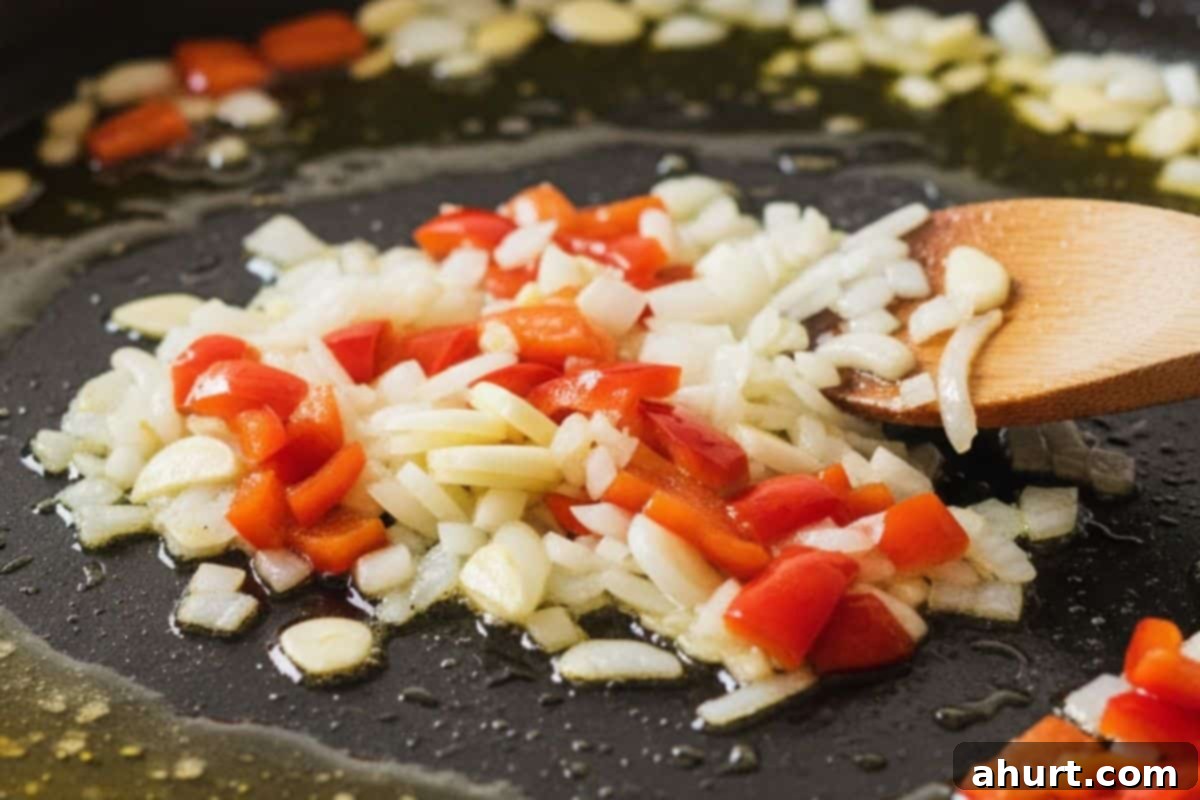
- Build the Sofrito Foundation: Begin by heating olive oil in your chosen pan (a paella pan, wide non-stick skillet, or cast iron) over medium heat. This is where the magic starts. Add the finely chopped onion, minced garlic, and diced red bell pepper. Sauté these aromatics gently for about 3-5 minutes, stirring occasionally until the onion becomes soft, translucent, and fragrant. This step creates the essential flavor base for your paella.
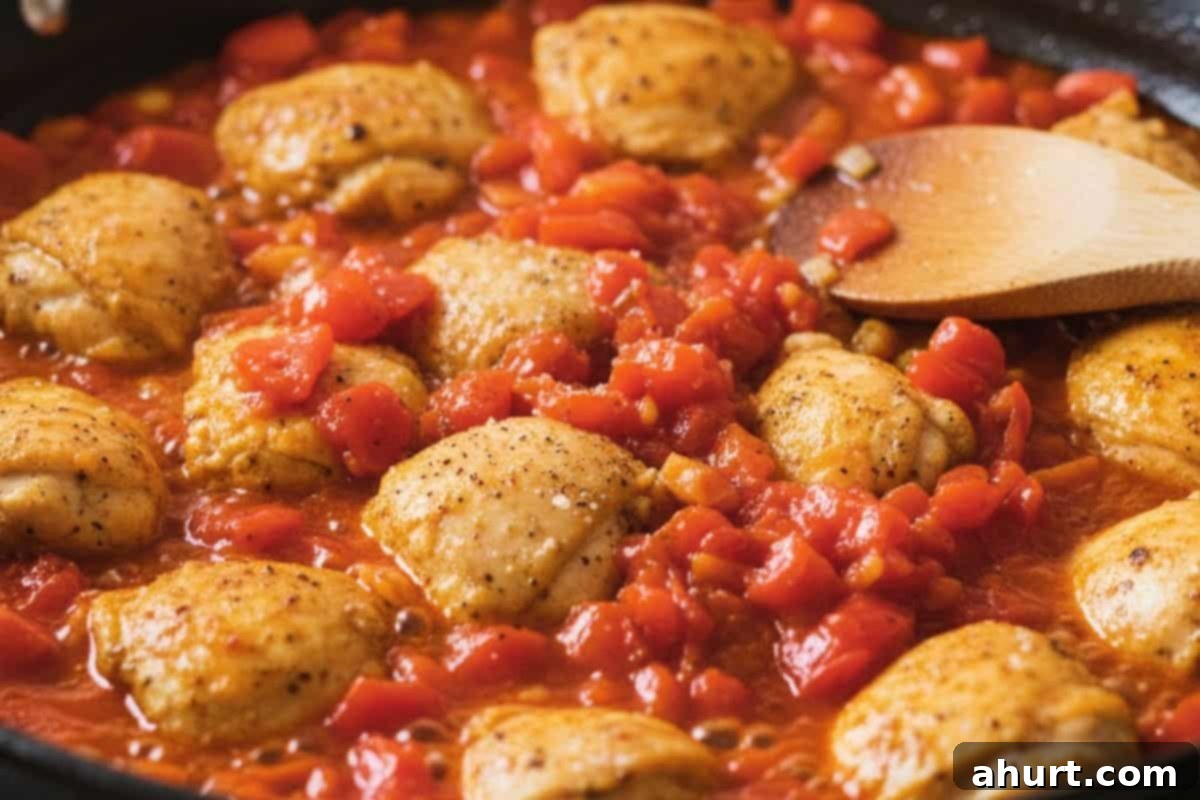
- Brown the Chicken and Develop Tomato Sauce: Push the aromatics to the side of the pan and add the bite-sized chicken thigh pieces. Cook them until they are beautifully golden brown on all sides, ensuring they develop a rich, savory crust. Next, stir in the chopped fresh tomatoes, along with a generous pinch of salt and pepper. Continue to cook for about 5-7 minutes, stirring occasionally, until the tomatoes break down and release their juices, forming a luscious, flavorful sauce. This step is crucial for depth.
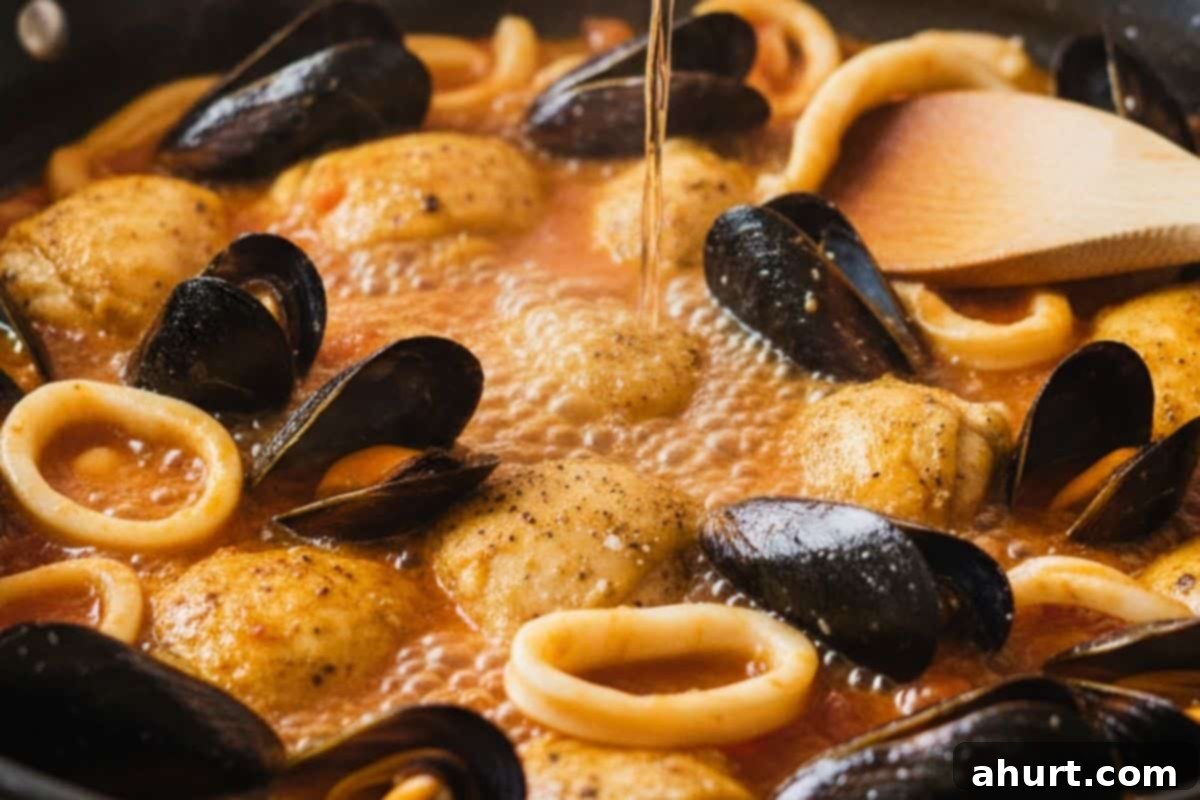
- Infuse with Seafood and Wine: Gently nestle the cleaned mussels and calamari rings into the tomato-chicken mixture. Pour in the dry white wine (if using). Allow the mixture to simmer for about 5 minutes, letting the wine reduce by half. During this time, the seafood will begin to release its juices and partially cook, infusing the entire dish with a wonderful oceanic aroma.
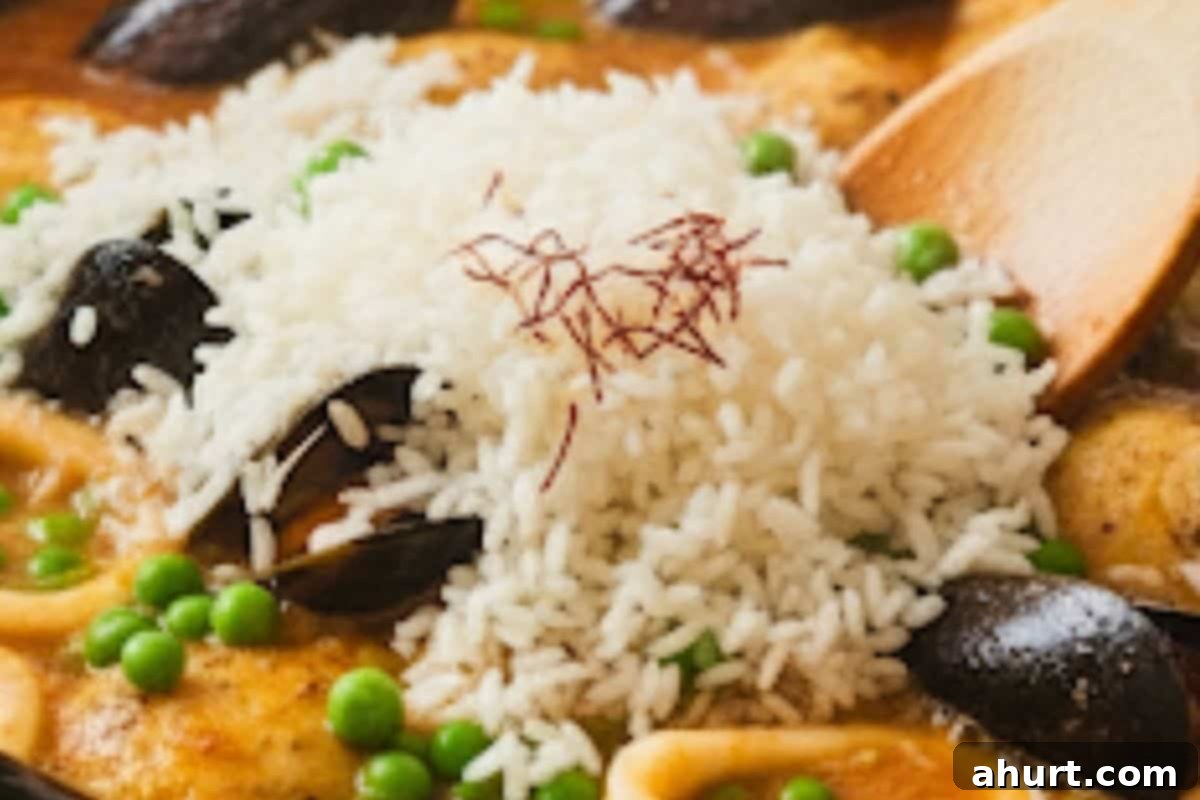
- Add Rice, Broth, and Saffron: Now for the star of the show! Pour in the chicken or fish stock, ensuring it’s simmering hot if possible. Add the medium-grain rice, frozen peas, saffron powder (or steeped threads), paprika, garlic powder, and onion powder. Stir everything gently but thoroughly to ensure the rice is evenly distributed and coated with the flavorful liquid and spices. This is the last time you’ll stir vigorously – resist the urge to stir once the rice starts cooking, as this helps develop the precious socarrat.
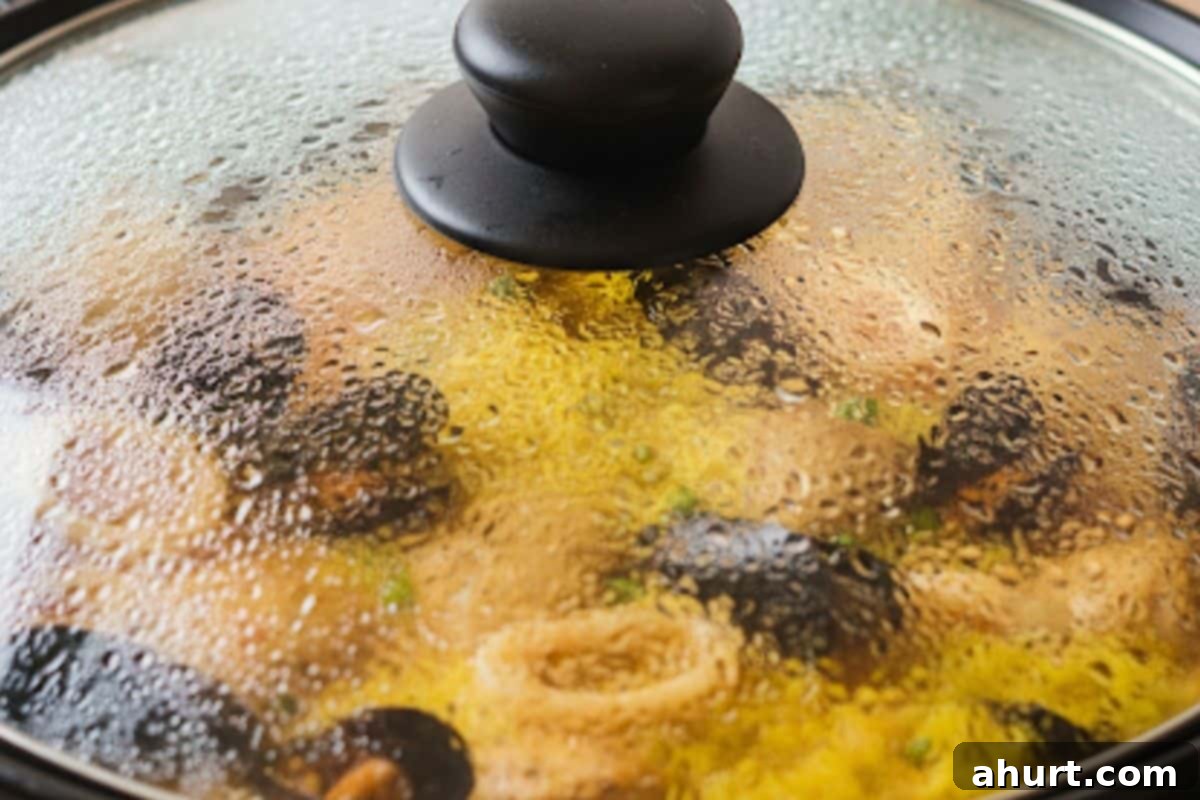
- Simmer to Perfection: Bring the entire mixture to a gentle boil over medium-high heat. Once boiling, immediately reduce the heat to low, cover the pan tightly, and allow the paella to simmer undisturbed. This crucial period, typically around 15-20 minutes, allows the rice to absorb most of the liquid and cook through. Resist the urge to stir frequently, as this disrupts the formation of the socarrat. Check occasionally to ensure it’s not sticking excessively to the bottom.
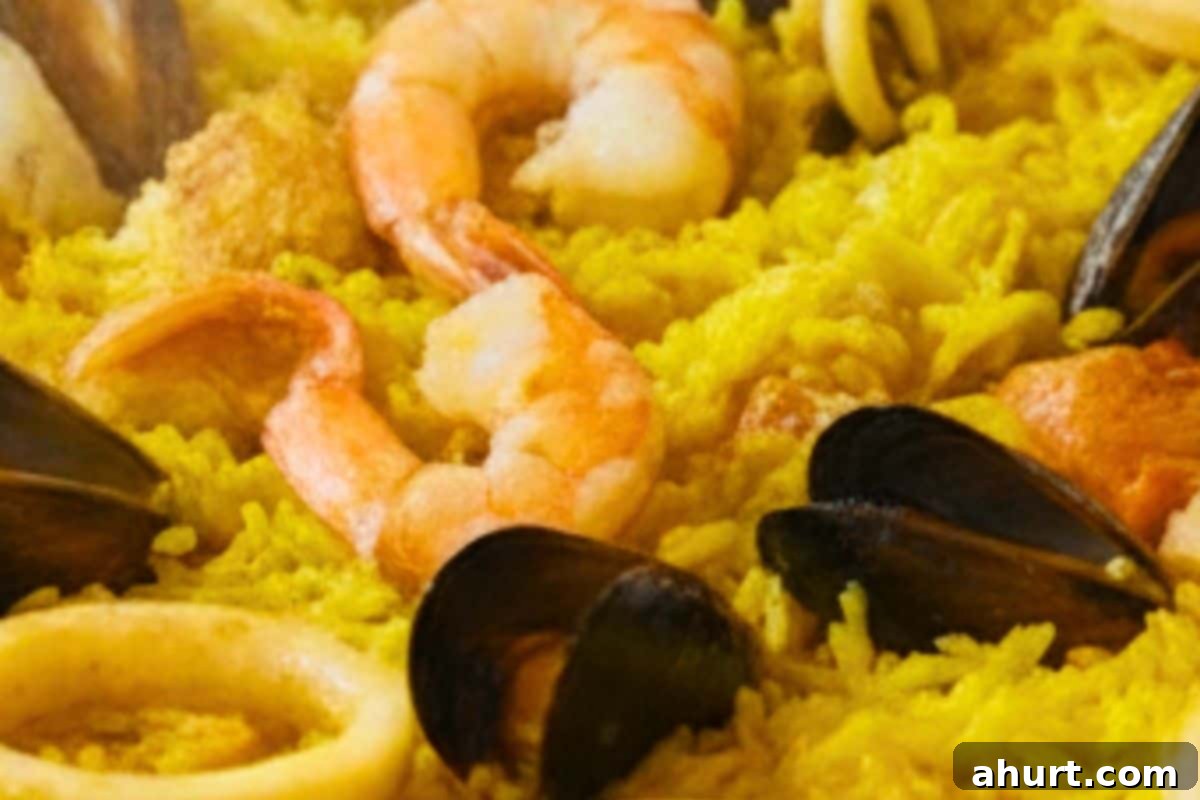
- Incorporate the Shrimp and Finish Cooking: Once the rice is nearly cooked (it should still have a slight bite), gently fold in the raw shrimp, distributing them evenly over the surface. Cover the pan again and continue to cook for another 5-8 minutes, or until the shrimp turn opaque pink and the rice is fully tender. The mussels should have opened fully by now; discard any that remain closed.
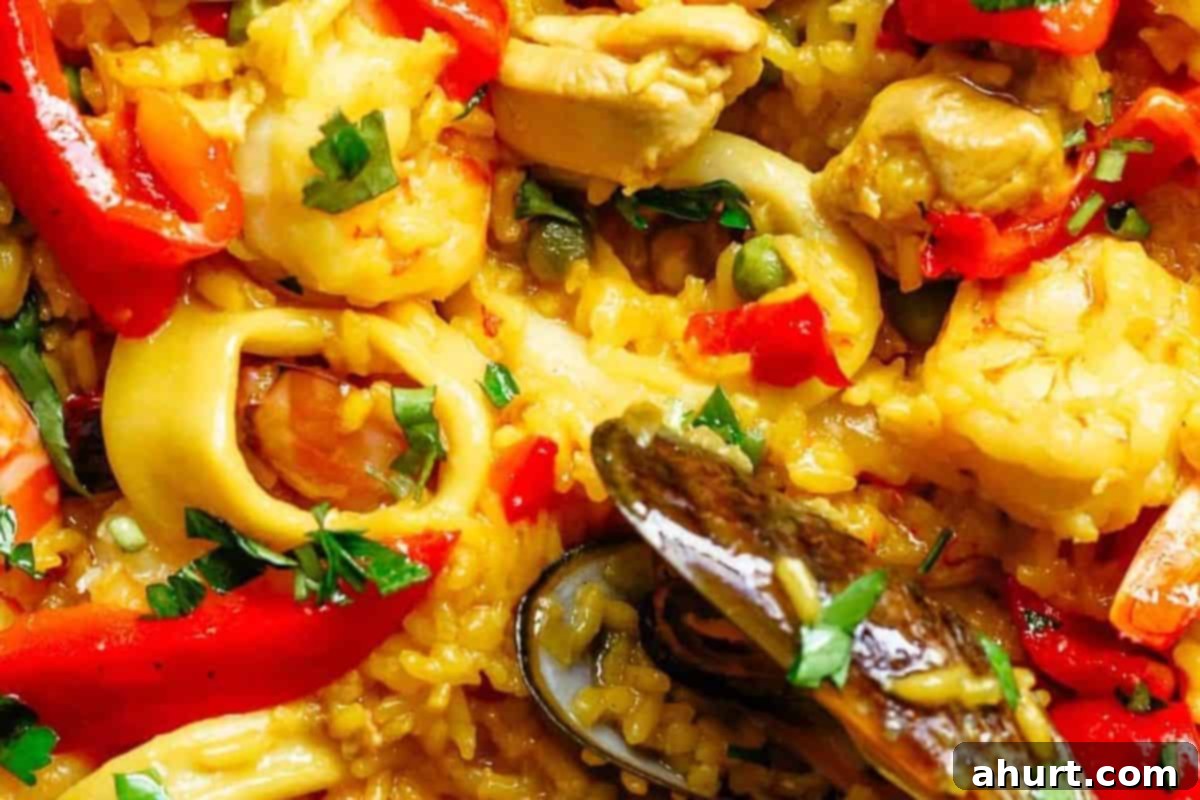
- Garnish and Rest for Flavor Development: Once the paella is cooked, remove it from the heat. Sprinkle generously with fresh chopped parsley and artfully arrange the fire-roasted bell pepper strips over the top for a final flourish of color and flavor. This is also the critical moment to achieve the socarrat! Uncover the paella, and if your rice is not quite crispy on the bottom, increase the heat to medium-high for 1-2 minutes, listening for a gentle sizzling sound (but be careful not to burn it). Then, let the paella rest, uncovered, for about 5-10 minutes. This resting period allows the flavors to meld and the rice to properly set, making it easier to serve.
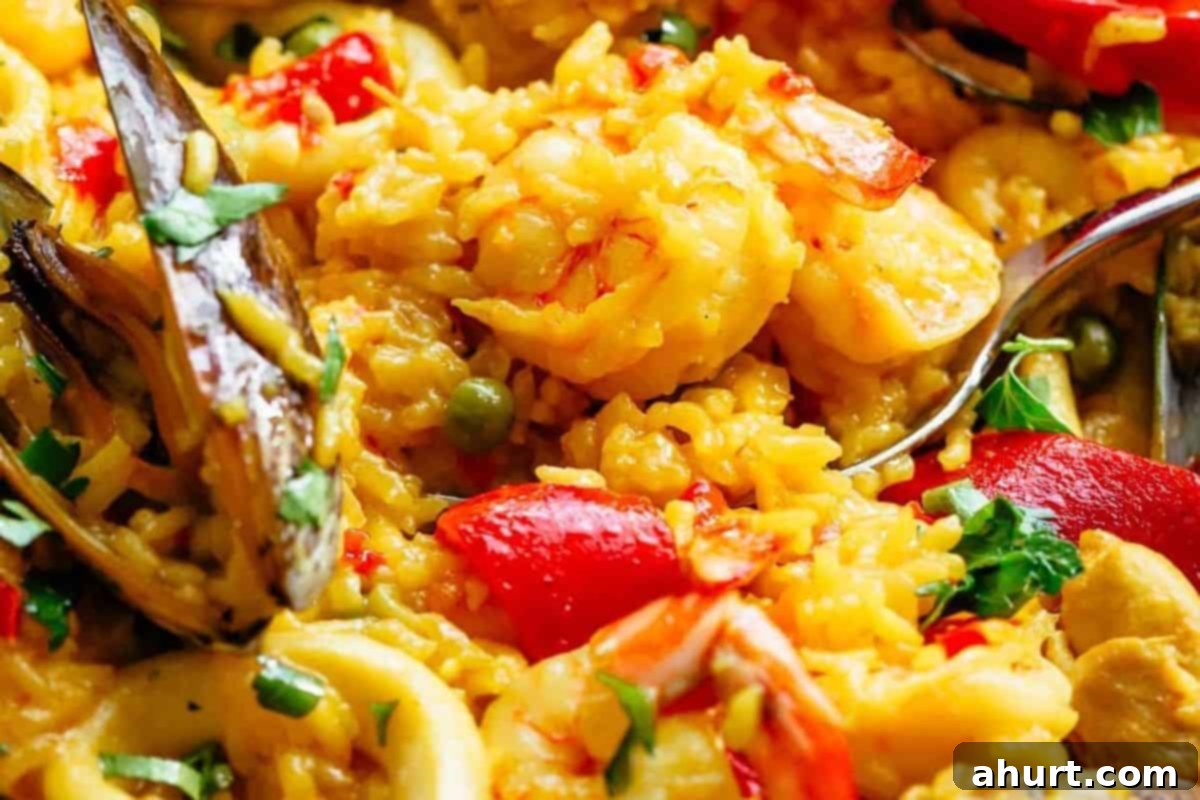
- Serve and Savor the Socarrat: Before serving, drizzle a final touch of high-quality extra virgin olive oil over the finished paella for an added layer of richness and sheen. Serve the paella directly from the pan, allowing everyone to admire its beauty. When scooping, remember to reach deep into the bottom of the pan to retrieve those prized pieces of golden, crispy socarrat – it’s often considered the best part! Enjoy this vibrant, flavorful dish with friends and family.
To perfectly complement your exquisite Spanish Paella, consider a range of light and flavorful pairings. For a delightful textural contrast and a burst of garlicky freshness, serve a side of Tomato Bread (Pan Coca). Alternatively, a vibrant and refreshing twist can be found in Chili Lime Cowboy Caviar, offering a bright acidity that cuts through the richness of the paella.
If you’re inclined to lean into a more indulgent experience, consider side dishes that enhance the seafood synergy. Succulent Garlic Butter Shrimp or perfectly cooked French Steamed Mussels make excellent companions, echoing the flavors within the paella itself. For those who crave something hearty and comforting, options like crispy Garlic Butter Smashed Sweet Potatoes or irresistible Truffle Fries provide a golden, satisfying balance to the main course.
Your Paella Questions Answered: Recipe FAQs
While traditional Spanish paella typically calls for short or medium-grain rice varieties like Bomba or Calasparra due to their excellent absorption properties without becoming mushy, other alternatives can be used. If these specific types are unavailable, a good quality medium-grain rice will work well. In a pinch, Arborio rice (commonly used for risotto) or even jasmine rice can be substituted, though be aware that the final texture may vary slightly. The key is a rice that holds its shape and absorbs liquid without becoming sticky, crucial for developing that prized socarrat crust.
Absolutely not! While a traditional paella pan (known as a paellera) is designed for optimal heat distribution and wide surface area, it’s not a requirement for making delicious paella at home. A large, wide non-stick skillet or a well-seasoned cast iron pan with low sides will work perfectly fine. The crucial element is a wide surface that allows the rice to spread out in an even, thin layer, which is essential for uniform cooking and, most importantly, for achieving that delightful golden socarrat crust on the bottom.
Socarrat is arguably the most coveted and delicious part of an authentic paella. It refers to the crispy, caramelized, toasted layer of rice that forms at the very bottom of the pan. It’s not burnt, but rather a nutty, intensely flavorful crust that provides an incredible textural contrast to the tender rice above. To achieve this culinary treasure, resist the urge to stir the rice once the liquid is mostly absorbed (around 5-10 minutes before the end of cooking). Instead, let the rice continue to cook undisturbed over low to medium-low heat for a few minutes. You’ll know it’s forming when you hear a gentle sizzling sound and can smell a toasted aroma. Be careful not to let it burn, though! A quick peek with a spoon can confirm its golden-brown perfection.
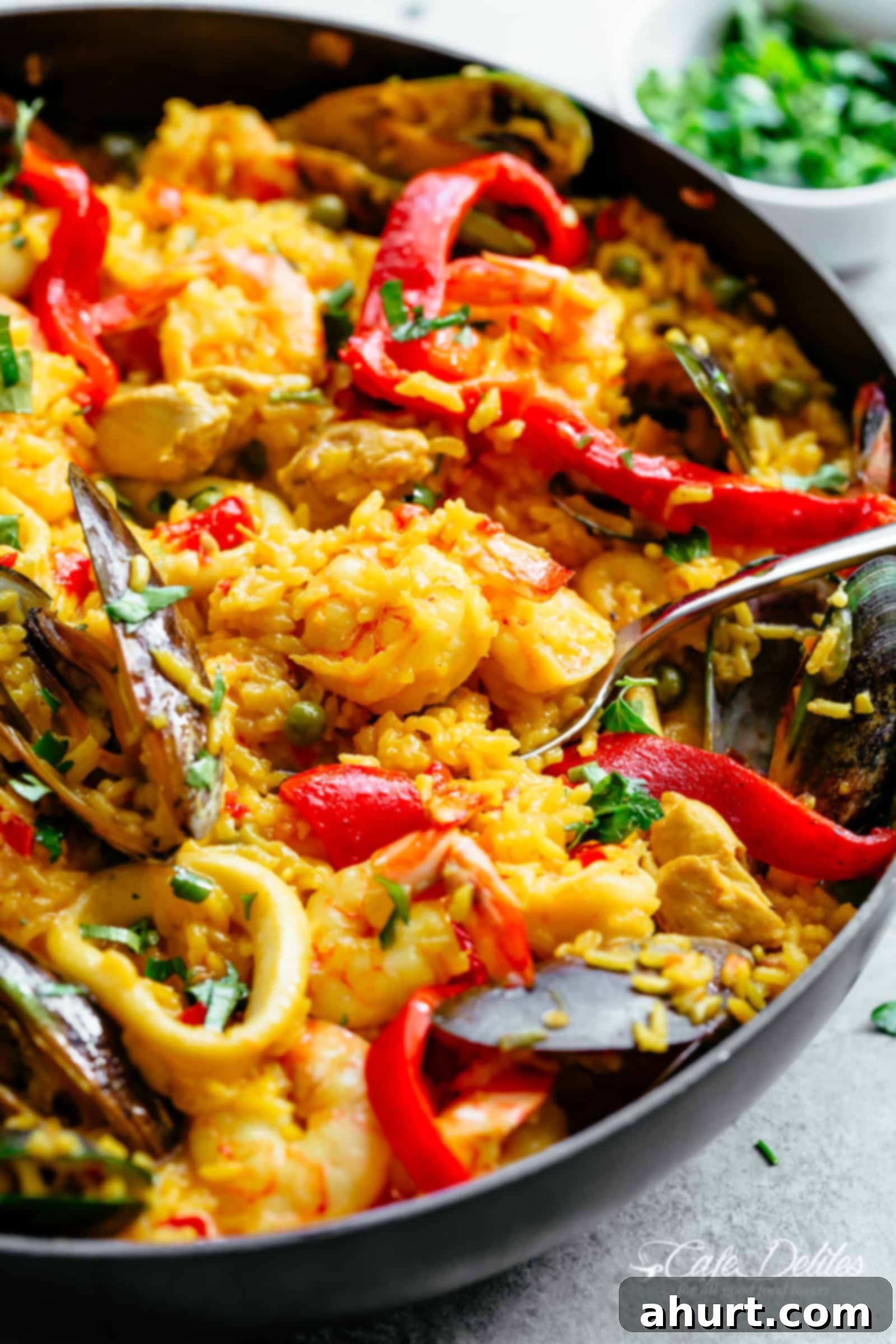
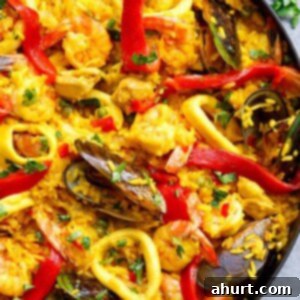
Pin
Classic Spanish Paella
Ingredients
- 2 tablespoons olive oil
- 1 large onion chopped
- 6 cloves garlic large, finely chopped
- 1 small red bell pepper diced into small pieces
- 4 large boneless skinless chicken thigh fillets cut into bite-sized pieces
- 4 large tomatoes chopped, for the sofrito base
- 1/2 cup dry white wine such as Sauvignon Blanc or Pinot Grigio (optional, but adds depth)
- 1 pinch salt to taste
- 1 pinch pepper to taste
- 10-12 mussels scraped, de-bearded, and cleaned properly
- 8 ounces calamari rings fresh or frozen, thawed
- 3 3/4 cups low sodium chicken broth or quality fish stock, heated
- 2 cups medium grain rice (e.g., Bomba, Calasparra, or a good quality medium grain)
- 1/2 cup frozen peas thawed
- 1 teaspoon saffron powder or saffron threads steeped in a little warm broth
- 1 teaspoon paprika sweet or smoked, for authentic flavor and color
- 1/2 teaspoon garlic powder
- 1/2 teaspoon onion powder
- 21 ounces shrimp (prawns), peeled, deveined, tail-on or off
- 2 tablespoons fresh flat leaf parsley chopped, for garnish
- 1 tablespoon fire roasted bell peppers strips (or jarred roasted red peppers, sliced)
Instructions
-
Heat the olive oil in a large sized non-stick pan or a well-seasoned skillet (or a traditional paella pan if you have one) over medium heat. Add the chopped onion, minced garlic, and diced red bell pepper. Sauté gently until the onion is soft and translucent, about 3-5 minutes, creating a fragrant sofrito base.
-
Add the chicken thigh pieces to the pan and sauté until they are beautifully golden on all sides. Stir in the chopped tomatoes, seasoning with salt and pepper to taste. Cook for 5-7 minutes, stirring occasionally, until the tomatoes break down and form a rich, thick sauce.
-
Introduce the dry white wine, mussels, and calamari rings to the pan. Allow the mixture to simmer for a further 5 minutes, letting the wine reduce by half and the seafood begin to cook slightly. Then, pour in the hot chicken or fish stock, add the medium grain rice, thawed frozen peas, saffron powder, paprika, garlic powder, and onion powder. Mix all ingredients gently but thoroughly until well combined and the rice is evenly distributed. Do not stir vigorously after this point.
-
Bring the mixture to a gentle boil over medium-high heat. Immediately reduce the heat to low, cover the pan tightly, and allow the paella to simmer undisturbed for approximately 15-20 minutes. This allows most of the liquid to be absorbed into the rice and helps in developing the desired socarrat crust at the bottom. Avoid stirring too much, as this inhibits socarrat formation and can make the rice mushy. Cook until the rice is ALMOST cooked through, still having a slight bite.
-
Once the rice is nearly cooked, gently nestle the shrimp (prawns) into the rice, distributing them evenly. Cover the pan again and continue to cook for another 5-8 minutes, or until the shrimp turn opaque pink and the rice is fully tender. Ensure any mussels that haven’t opened are discarded.
-
Once fully cooked, remove the paella from the heat. Sprinkle generously with fresh chopped parsley and artfully arrange the fire-roasted bell pepper strips over the top. If desired, you can briefly increase the heat to medium-high for 1-2 minutes to enhance the socarrat before letting it rest. Let the paella rest, uncovered, for about 5-10 minutes to allow the flavors to meld and the rice to settle before serving. Drizzle with a small amount of extra virgin olive oil over the top for added richness.
Notes
Chicken: Boneless, skinless chicken thighs are preferred for their tenderness and ability to absorb flavor. You can substitute with bite-sized pieces of pork loin or even rabbit for a more traditional Valencian style paella. Ensure meat is browned well.
Rice: The success of paella hinges on the right rice. Medium-grain varieties like Spanish Bomba or Calasparra are superior due to their high absorption capacity. If unavailable, good quality medium-grain rice or jasmine rice can be used, but avoid long-grain or instant rice.
Fire-Roasted Peppers: To make your own fire-roasted bell peppers, place whole peppers directly over a gas flame or on a hot grill, turning frequently until the skin is completely charred and blistered. Place them in a bowl, cover with plastic wrap for 10-15 minutes (this steams them and makes peeling easier), then peel, core, and slice into strips. Jarred roasted red peppers are a convenient alternative.
Socarrat Tip: For the ultimate socarrat, listen closely! Towards the end of the cooking, you’ll hear a distinct crackling sound from the bottom of the pan. This indicates the crust is forming. A slight increase in heat for the final minutes, without stirring, will help achieve a perfect golden bottom.
Nutrition
Nutrition information is automatically calculated and should be used as an approximation. Individual results may vary based on exact ingredients and preparation methods.
